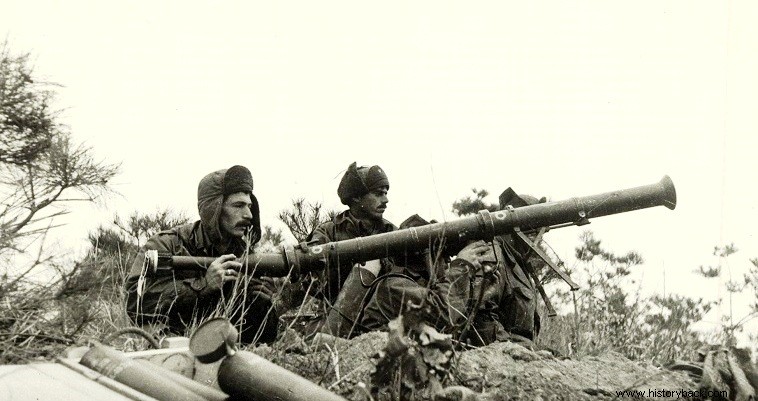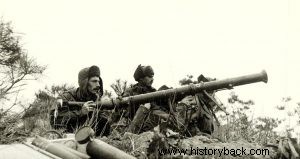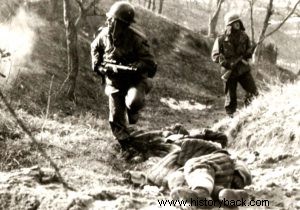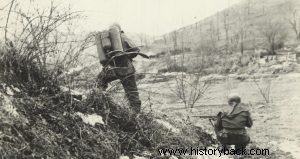
The Korean War began as a military conflict between the two states of divided Korea, which began on June 25, 1950, but soon developed into a conflict between the two worlds of the time, East and West. The dividing line of Korea into North and South was the 38th parallel of the Korean Peninsula. The violation of the border and the invasion of North Korea into the territories of South Korea caused the retreat of the forces of the latter and the beginning of the war, which lasted until July 27, 1953.
The Greek Expeditionary Force
Greece, in 1950, in the framework of the implementation of the decisions of the United Nations (UN), sent to the Korean peninsula a military force, of a special composition, which was called the Hellenic Expeditionary Force (EGF). The EKSE was the first Greek mission within the UN and included army and air force forces.
The initial strength of the EKSE was approximately 1000 men and consisted of the Staff - Command and Battalion of the Hellenic Expeditionary Force, as well as an air force squadron of 67 people and 7 C-47 aircraft. Colonel (PZ) Daskalopoulos Ioannis was appointed as the head of the expeditionary force, while the commander of the battalion was Lieutenant Colonel (PZ) Arbouzis Dionysios.
In the afternoon of the following day (November 15, 1950), the EKSE was transported by rail (from the barracks area in Ruf) to Piraeus where it was boarded on the American gunboat "General Han" and after a 24-day voyage, it sailed on 09 December 1950 at the port Pusan, South Korea. The strength of EKSE at this particular time was 840 people.
During the initial period of time in the Allied perimeter of Pusan in South Korea, deficiencies in operational materials, (vehicles, radios, armament, ammunition, living materials and DM means) were filled. On December 14, 1950, the EKSE moved to the Suwon area thirty kilometers south of Seoul - which at the time was under enemy occupation - and remained until December 30, 1950, when it moved to enter in the fight. During the entire period of stay in Suwon, the battalion was engaged in operational training.
Entry of EKSE in the Competition
From 18 December 1950 the EKSE was placed under the 7th US Cavalry Regiment of the 1st US Cavalry Division, as the fourth battalion of the 7th Cavalry Regiment. Contributed decisively to the stabilization of the front, carried out offensive reconnaissance in the Sayon-Ni area and Hill 406 north of Yixon city where it suffered the first losses from enemy fire, repulsed on Hill 381, near Yixon, a strong attack by a Chinese regiment after a strong defense , carrying out his first major military operation.
The battles in which the EKSE participated were hard and bloody, they took place in unfamiliar territory and in particularly difficult climatic conditions, with severe cold and snow in the winter and continuous rains in the spring, which turned the area of operations into a particularly difficult terrain. Despite the difficult conditions and the more numerous enemy he faced, the morale of the EKSE men was flourishing and their militancy at a high level, with the main characteristic being the will and stubbornness to win.
The continued successes on the battlefield caused the admiration of the Allies:"The Greek division, a pioneer among the active Allied Armies in the central sector of the front, as the piston-head of an attacking mass, wins a decisive victory and opens the way for the Allied troops to Hokchon - Chungcheon, South Korea's most important hub" (Allied Communiqué - Archive DIS/F.161/18/A/4).
Battle of High Harry (Night 17/18 June 1953)
One of the fiercest battles of the war took place on the legendary Harry Hill, just a few weeks before the armistice was signed and the war on the Korean Peninsula ended.
On May 17, 1953 the Battalion of the Expeditionary Force, under orders from the 15th US Regiment, to which he had joined, moved towards the "Missouri" line where he installed himself defensively. On June 16 he moved to the defensive location of the 2nd American Battalion, in whose sector was the "Harry" hill. In the new location he was mainly concerned with improving the organization of the terrain, and installing ambushes and listening posts in relevant places.
Due to the impending armistice which would provide as a line of separation between the two adversaries, the location occupied by both sides at the time of signing the armistice, both adversaries tried to take advantage of the situation as much as they could. Since the armistice would see the adversaries each retreat two kilometers from the line of contact to create the demilitarized zone, they struggled to maintain strong outposts on tactically important heights that commanded along the front and provided the advantage of observation deep into of the opposing location.
This meant that the enemy, who was at a disadvantage on the ground, had to retreat even further to cover his forces from observed artillery fire and organize his defenses on the first suitable heights. The Chinese therefore, who had gaps in their formation, tried to occupy or re-occupy such heights that the allied forces held as quickly as they could with repeated offensive actions.
One such hill, among others, was the hill codenamed "Harry". The hill was occupied since the beginning of June by the Puerto Ricans of the 2nd Battalion of the 15th American Regiment. From the 10th to the 13th of June the 15th Regiment during the operations to capture "Harry" from the Chinese, used for its defense periodically all three (3) organic American battalions, with total losses of more than 250 killed and 400 wounded. Due to the criticality of the situation in which the American battalion had fallen, it was decided on June 13, 1953, to be replaced by the Greek battalion.
At an elevation of around 350 meters, Harry Hill was about 400 meters in front of the Allied Frontal Position (FOT) and was the highest allied hill within a 2 kilometer radius. From this they could control all approaches to their defensive line. It was the southern end of a larger massif with the highest point being the "Star" hill, which was occupied by the Chinese at that time. The distance between the two heights in a straight line did not exceed 300 meters.
The enemy actions against Harry Hill were part of a larger plan of offensive action aimed at breaking up the defensive position of the US 3rd Division. By occupying the height, the defense on the site would be difficult and the enemy would be able to control with fire the road network over a large area and at a depth of 10 kilometers. For this reason, the "Harry" hill was a strategic objective as it opened the way to Seoul, the capital of South Korea.
The Greek battalion, without any procrastination and with extreme secrecy and method, began the organization of the ground while simultaneously repairing the damage caused by the intensity of the enemy's bombardment. Thus on the morning of June 16 he had completed his installation on the hill. The battalion commander modified the fire plan and changed the layout of holding the site, studied and organized strong counterattacks by a complex of infantry and tanks, which the battalion promptly requested and received. The events that followed fully vindicated him.
The Chinese attack
On the night of June 17/18, the attempt by the Chinese to capture it began, with heavy bombardment along the entire front of the Greek battalion. The Chinese, as on previous nights, after a strong artillery preparation, attacked in waves, believing that their large number of infantry would achieve a decisive result. The defenders' fire was thunderous, artillery and mortar barrages were activated but did not stop the offensive momentum.
The corpses of the Chinese were piling up, but despite heavy losses, they sent another wave. The defenders fired at will in their designated sector while the group weapons fired according to the fire plan. The grenades were defused and let roll downhill in succession, decimating anyone they encountered upon detonation. The Chinese having approached the northern trenches and preparing for the final jump, began hurling grenades. Then the Greeks charged with a "lance weapon" and a hand-to-hand battle ensued.
Despite their numerical superiority, the Chinese were surprised by this sudden counter-attack by the Greeks, who were rushing down the slope with their bayonets in the darkness, and retreated, opening up the distance from the defensive position and thus giving the artillery an opportunity to attack them. it hits mercilessly at the predetermined concentrations. The Chinese, despite the overwhelming losses, did not give up.
After a while they repeated a more massive attack on the northern trenches. They entered the first positions and with their artillery tried to create a security ring to stabilize themselves.
Then the Greek commander decided to engage his reserve, a Greek company and an American tank platoon, which flanked the Chinese divisions and forced them to leave the positions they had occupied. In the early morning of June 18, the Chinese, definitively defeated, and having suffered huge losses, retreated and abandoned all further attempts to capture "Harry" Heights.
The Greeks held on and began to count their wounds. Everyone expected heavy losses and especially the Americans who had seen their companies decimated. The Greek losses during the stay of the EKSE in Korea were 6 dead (1 Officer and 5 soldiers) and 19 wounded. The total Allied losses during the battle of the 15th American Regiment and the Hellenic Battalion were 102 killed and 553 wounded.
On the enemy side the total losses from June 10 to 18 were 223 dead counted, 1450 dead by calculation and 3800 wounded by calculation. The irony of fate is that after the armistice agreement was signed on July 27, 1953, the hill, designated "neutral," was exempted from occupation, and both sides withdrew from it. Nevertheless, the sacrifice was not completely pointless and had indirect results as it was seen later. Because of this resistance, the fertile Kum-Hua Valley remained in the hands of the South Koreans.
Epilogue
For the war work carried out by the EKSE, it was awarded special honors, both Greek and allied. Also, many Officers and soldiers were honored with promotions to meritorious service and Greek, American, South Korean, Belgian, Colombian and U.N. awards. decorations, medals and honorable mentions. With these distinctions, the representation of the Greek Army under the EKSE in the international arena of the struggle for freedom, during the operations in Korea, was now officially recognized.
Later, South Korea, to show its gratitude, erected at the site of Yeonju Kyun Ji Do (the famous Valley of Heroes), near Seoul, a magnificent monument to the fallen Greek fighters, on a slab of which there is the inscription:"These brave soldiers of Greece, they embodied the happy, the free, the free, the cheerful. Honor and glory to the fallen warriors!".



SOURCE:GES
